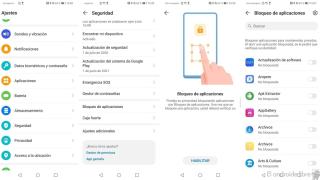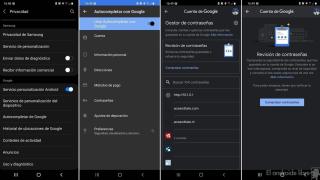Related news
Protecting our Android phones is one of the priorities of every user in Europe. Luckily, there are a number of security and privacy settings this will help us in this process and allow us to protect the phone in the best possible way, without needing to install anything.
Android security is an issue that worries many users, who are looking for ways to protect their phone. In our devices we already find various settings that will be useful: these are the 10 parameters we should use at any time.
Block access to your Android mobile
Android phone lock method
The first security parameter do on your phone is to block their accessi.e. set PIN or password, use fingerprint sensor or face unlock. We will therefore be the only ones who will have access to it. The steps to configure an unlock method are:
- Open the phone settings.
- Go to the security section.
- Enter biometrics or phone lock (name will depend on your personalization layer).
- Select the method to use on your phone (fingerprint, PIN code, etc.).
- Save this method.
- Confirm again.
Google Play Protect
One of the best security tools available on Android es Google Play Protect, because it is responsible for analyzing all the apps and games that we have downloaded from the Play Store. It is a good way to detect if malware, spyware or some other kind of threat has infiltrated our smartphone.
Also, thanks to Google Play Protect we will not have to install antiviruss on the phone. It’s a reliable security tool that just works and is already enabled by default on Android, so we don’t have to do anything to use it.
Google security analysis
Google Security Review
Our google account is closely linked to our Android smartphone. That is why we have to check that our Google account is also well protected and that there are no security or privacy issues and this is something that we can easily check:
- Open settings.
- Go to the Google section.
- Click Manage Google Account.
- Go to the Security section.
- Enter the first option to see if there are any problems.
Manage app permissions
Android app permissions
One of the most important settings on any Android phone is app permissions control. There are times when some the app has a permission it shouldn’t have and this causes problems because the app accesses our personal data or it may deploy malware on the phone. The steps for this are:
- Open settings.
- Go to the Applications section.
- Enter the app permissions.
- Check the permissions of each app.
- If there is a permission that an app shouldn’t have, remove it.
Lock apps with password or fingerprint
Lock the application by fingerprint
An option that is available in many layers of customization on Android and that there are already applications that natively offer (WhatsApp, Telegram …). This is a good way to protect your apps, by preventing someone from entering them without your permission and using them or reading your chats, for example.
- Open your mobile settings.
- Go to Security.
- Look for the App Lock option.
- Enter a pattern, password or use your fingerprint.
- Choose the apps you want to block.
Use secure Wi-Fi networks
How to see if a WiFi channel is saturated from your Android mobile
Most of us with an Android smartphone connect to a WiFi network every now and then. During this operation, several aspects must be taken into account, such as the use only of secure networks, therefore avoid the use of public WiFi networks, especially if we are going to enter a password or sensitive data.
In addition, there are layers of personalization that include additional measures to improve security when we connect to a WiFi network. In layers like One UI, we have options like secure WiFi or to notify us if suspicious activity is detected on a specific WiFi network.
Emergency information
Add emergency information
One option that Google itself recommends is adding emergency information to your phone’s lock screen, which is possible in different layers of the operating system. In this information you can add the message you want, but it will be useful.
From information about any allergies or illnesses you have, in an emergency, or who they should call. It can also be useful in case you lose your phone and someone finds it.
Find my device
It’s not so much of a fit, but it’s a great help safety tool for any user with an Android phone, which we can also use with accessories. This tool will tell us the location of the phone in case of loss or theft. In addition, it also allows us to block it, make it play a sound or put a message on the home screen. An essential tool, therefore.
- Enter the site of Find my device.
- Sign in to your Google account.
- Choose the device you are looking for.
- Locate that phone.
- If you want to ring him (if he’s near you).
Manage your passwords
The passwords we use accounts that we access from our Android phone may be exposed at some point. Fortunately, in our Google account there is a section where you can see if any of them have been leaked or need to be changed to improve security. You need to follow these steps:
- Open the phone settings.
- Go to Privacy.
- Enter AutoComplete.
- Go to the Passwords section.
- Click the top option of Check Passwords.
- Wait for the analysis on the status of your passwords to be performed.
Disable sending of Android usage statistics
Android usage statistics
Google has a number of usage statistics, which assume that data such as battery usage, app activity, system activity and other device usage data with them. This is something that many users don’t like so they decide to disable it, possible with these steps:
- Open settings.
- Go to the Privacy section.
- Click on Advanced.
- Find the section called Usage and Diagnosis.
- Disable this section.
If after all of this you feel like doing more, you can see what’s improved in Android 11, the changes for this summer, or the issues with some Samsung phones.
.
Table of Contents













